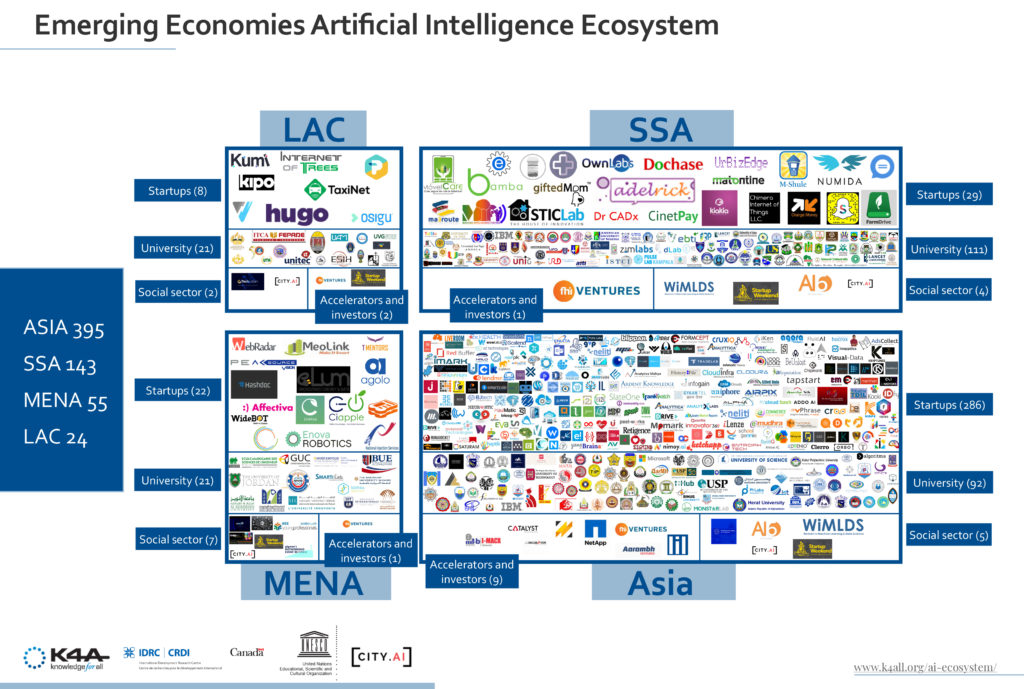Policy priorities: AI in developing countries
It’s no secret that artificial intelligence (AI) holds the key to unlocking treasure troves of economic value worldwide. PwC’s Global Artificial Intelligence Study estimates that domestic economies will experience up to a 26% boost in GDP from AI by 2030. From self-driving cars to the diagnosis of diseases, the substantial amounts of data becoming available to private and public entities is allowing this technology to perform many tasks at superhuman levels.
Aside from being a magical black box though, how can we thoroughly define AI?
Oxford Reference provides us with the following:
Artificial intelligence is the theory and development of computer systems able to perform tasks normally requiring human intelligence, such as visual perception, speech recognition, decision-making, and translation between languages.
With all of this in mind, some big questions remain: which countries will benefit most from AI and how can a country position themselves to do so?
Figure 1: An analysis of the approximate number of academic papers on AI being published by the Top 8 countries in this category worldwide (over a 20-year period). It’s important to note that these papers are published by research institutions of all types (e.g. universities, technology companies).
You might notice that most of these are developed countries. In fact, you might even notice that most of the media you’ve consumed surrounding the topic of artificial intelligence is centred solely around the likes of the U.S. and China. There are reasons for this, the main one being that these countries are the ones that have poured billions into the development of AI. They’re also home to the major players in the industry, such as Baidu, Alphabet and IBM.
Developing countries…left in the dust?
Where does this leave developing countries? Contrary to popular belief, artificial intelligence ecosystems do exist in emerging economies; the graphic below provides a short illustration of that. However, we must note that the size and rate of development of the AI industry in these regions are significantly smaller.
Figure 2: An overview into AI development within the private sector of key emerging regions. The legend for the titles are as follows: MENA for Middle East and North Africa, SSA for Sub-Saharan Africa, LAC for Latin America and the Caribbean.
For developing countries, however, most experts agree that a simple “adopt AI at all costs” attitude could prove to cause more harm than good. A commonly cited and misconceived fear of AI is the possibility of automation displacing many existing jobs. The reality is that most of AI development involves systems that predict and make decisions based on input from a countless number of data points; it’s the reason why such technology is far more effective at completing repetitive and specific tasks compared to something as complex as providing palliative care to a terminally-ill patient. Perhaps we’ll reach a future where the latter is possible, but for the time being, this isn’t the case.
A more feasible scenario surrounding unemployment that we can consider is the loss of blue-collar jobs, which are traditionally concentrated in developing countries. Over the past few decades, we’ve seen countries like India and China rise to global prominence after establishing themselves as the manufacturing powerhouses of the world; their irresistible low-cost labour is an attribute that has helped them to get to the position they’re at today. With automation, the proven path to economic prosperity may no longer be as simple as it once was. Furthermore, the new jobs that do become available will become limited to those countries that have the education infrastructure to retrain their workers or educate their youth on such technologies. In the continent of Africa, there are plenty of examples of countries that seem unable to do either; Ethiopia, Côte d'Ivoire and Mali all have a literacy rate of less than 50%. It should be acknowledged however, that some African countries do display promising outcomes in education and would be far more capable at adapting their workforce. As the only African country with a university in the world’s top 200 tertiary education institutions worldwide, South Africa is one shining example of this.
Nonetheless, the global inequality in wealth is also at risk of becoming larger with the onset of AI. Technological development is a costly process that is most often only able to occur with funding from the wealthy. It makes economic sense for this demographic to leverage the result of their investments and increase their own productive capacity – at least much more than to the benefit of the masses. What’s more concerning is that even if developing countries manage to foster talent in this emerging field, prime locations for technological augmentation (e.g. Silicon Valley, Toronto, Beijing) and particular firms are likely to attract talent from around the globe, making it difficult for poorer countries to retain their skilled workers in domestic industries.
That being said, AI does offer its benefits to developing countries. Most notably, the delivery of essential services such as healthcare and education can be easily scaled with the technology – making its development a double-edged sword.
Due to these potential dangers, most experts agree that for developing countries, a certain degree of proactiveness is needed for the development of AI. Prudent regulation must also be designed and enforced. Such challenges require sustained financial commitment and effort from policymakers. However, considering the above, achieving success in this regard will be very much worth it – at least when compared to countries with stable economies. Currently, we are nowhere near such a scenario.
Figure 3: Current state of the global adoption of national AI strategies
If you’re interested in exploring this topic further, head down to the Additional Resources section and keep an eye out for the next edition of the Impact Update. We’ll soon be looking at how specific developing countries size up against the world’s powerhouses in terms of AI development.
Author: Alden Vong | Communications Officer



